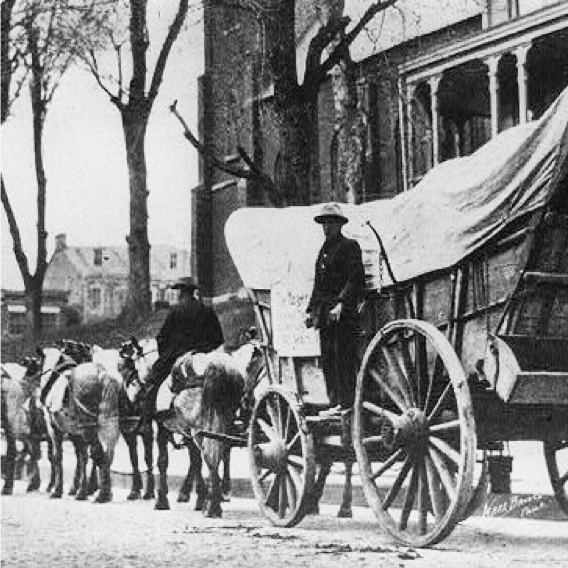In 1750, freight wagons were a new transportation technology that transformed travel and commerce. These wagons were built to move goods between remote white settlements in Virginia and the Ohio River Valley to more established settlements like Baltimore, New York, and Philadelphia.
The Coffman Wagon was employed by local merchants beginning in the late 1700s.
The Coffman Wagon was employed by local merchants beginning in the late 1700s. The freight wagons allowed settlers in the Greenbrier Valley to sell raw goods like furs and ginseng for finished goods like silk and shoes. By the mid-1800s improved methods of freight transportation became available and the Coffman wagon was no longer used.
In 1988, the two-hundred-year-old Coffman Wagon was gifted to the city of Lewisburg and a restoration process began.
In 1988, the two-hundred-year-old Coffman Wagon was gifted to the city of Lewisburg and a restoration process began. Don Birkebile, a former curator from the Smithsonian Institute, spent fifteen months restoring the wagon. The process involved removing, cleaning, and replacing each piece of the wagon. Today, the Coffman Wagon maintains 95% of its original ironwork and 90% of its original wood. To safely store the wagon, this wagon house was built on the grounds of the Greenbrier Historical Society in 1992.
The wagon house exhibit examines the economy of early colonial settlement of the Greenbrier Valley between 1770 and 1820. During this period European immigrants and enslaved Black people settled in the Greenbrier Valley with a variety of skills. The community had two economic systems; a subsistence economy in which people produced enough to survive and a market economy in which people produced enough surplus to trade and sell. European settlers used both economic systems to improve their standard of living.
Settlers relied on Native American knowledge…
Settlers relied on Native American knowledge, the unpaid labor of enslaved people, and the ability of women to take on traditional and non-traditional roles. Over time there was a shift from a predominantly subsistence economy to mainly a market economy. To learn more about early Greenbrier Valley settlers, visit the Road to Plenty exhibit on the grounds of the North House Museum and Archive.
– Abigail Smith, AmeriCorps Member at North House Museum. HashtagWV #132. June 2021.
HashtagWV Art & Entertainment is a high-quality print and digital multimedia platform for all things West Virginia and the greater Appalachian region. The editorial focus is local music, unique shopping, the arts, events, theatre, and food and drinks. tiktok.com/@hashtagwv
-
HashtagWVhttps://hashtagwv.com/author/hashtagwv/
-
HashtagWVhttps://hashtagwv.com/author/hashtagwv/
-
HashtagWVhttps://hashtagwv.com/author/hashtagwv/
-
HashtagWVhttps://hashtagwv.com/author/hashtagwv/





